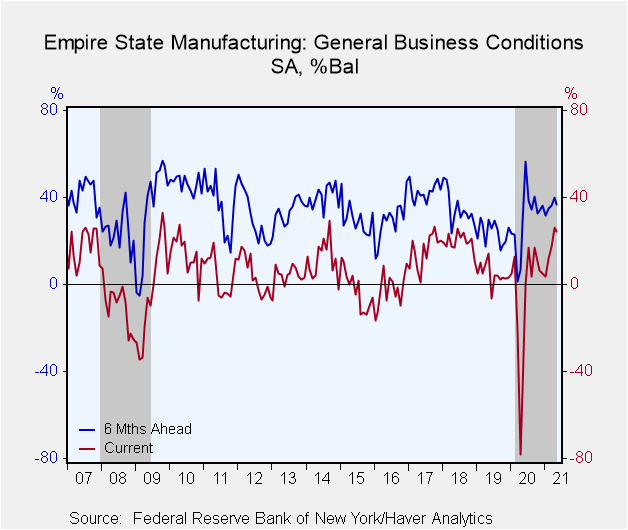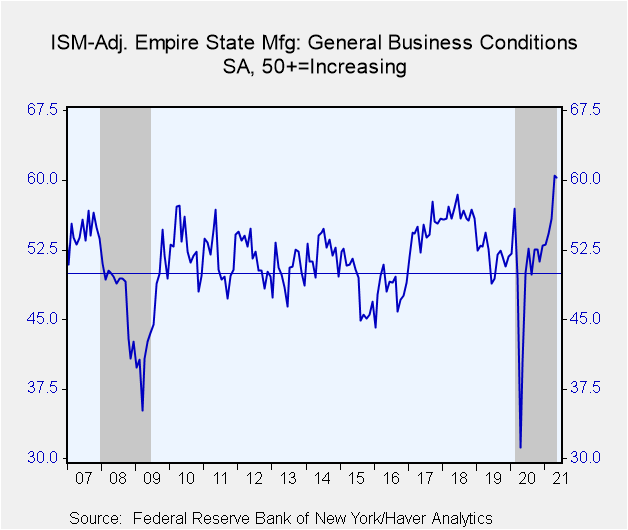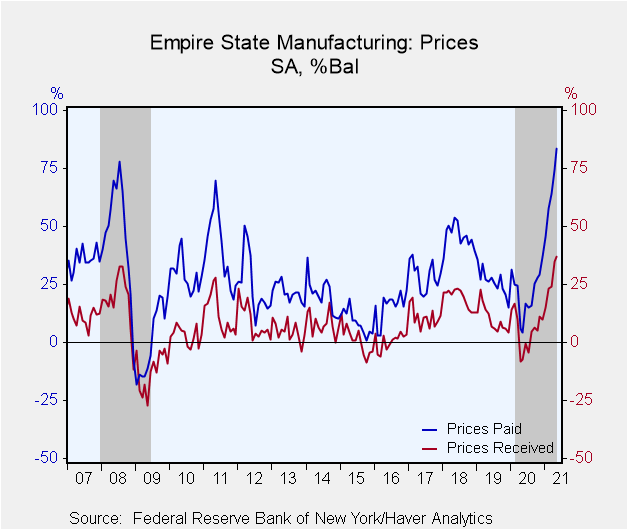 Global| May 17 2021
Global| May 17 2021U.S. Empire State Manufacturing Activity Remains Strong in May
by:Tom Moeller
|in:Economy in Brief
Summary
• Activity index eases m/m but remains near recent highs. • New orders strengthen while employment grows modestly. • Prices paid continue to surge. The Empire State Manufacturing Index of General Business Conditions fell two points to [...]
• Activity index eases m/m but remains near recent highs.
• New orders strengthen while employment grows modestly.
• Prices paid continue to surge.
The Empire State Manufacturing Index of General Business Conditions fell two points to 24.3 during May but remained near its recent high. A reading of 23.9 had been expected in the Action Economics Forecast Survey. A slightly lessened 37% of respondents reported improved conditions while a fairly steady 13% reported that conditions had worsened.
Haver Analytics constructs an ISM-Adjusted Empire State diffusion index using methodology similar to the ISM series. The latest reading of 60.3 was little changed m/m and up from 40.5 twelve month ago.
Amongst the components of the Empire State Survey, the orders series rose to 28.9 after surging to 26.9 in April while the shipments measure improved to 29.7 from 25.0 last month. Unfilled orders also edged higher to 21.4 after strengthening to 21.2 from 4.0 in March. Working lower was the delivery time index to 23.6, indicating quicker delivery speeds. Despite the m/m decline, the index remained up from 0.7 six months ago, thus showing that delivery speeds have slowed significantly versus then. Inventories also fell to 7.1 and reversed the April rise.
The index for the number of employees eased to 13.6 from 13.9 in April. A slightly lessened 20.0% of respondents reported more hiring while 6.4% reported less, edging lower from April. The average workweek reading rose to 18.7, the highest reading since May 2011.
Prices paid surged to a record 83.5 from 74.7 in April, indicating sharply stronger price gains. Eighty-four percent of respondents cited higher prices while none paid less. The prices received measure also surged to a record 37.1 from 34.9 in April.
The index of business conditions in six months eased to 36.6 this month from 39.8 in April. Expectations for new orders, shipments and employment dipped m/m along with price expectations.
The Empire State data, reported by the Federal Reserve Bank of New York, reflect business conditions in the manufacturing sector in New York, northern New Jersey and southern Connecticut. The data was collected between April 2 and April 9. The headline measure is constructed from the answer to a single question on business conditions. The Empire State figures are diffusion indexes, which are calculated by subtracting the percent of respondents reporting declines from those reporting gains. The data are available in Haver's SURVEYS database. The ISM-adjusted headline index dates back to 2001. The Action Economics Forecasts can be found in Haver's AS1REPNA database.
| Empire State Manufacturing Survey | May | Apr | Mar | May'20 | 2020 | 2019 | 2018 |
|---|---|---|---|---|---|---|---|
| General Business Conditions (Diffusion Index, %, SA) | 24.3 | 26.3 | 17.4 | -48.5 | -5.9 | 4.8 | 19.7 |
| General Business Conditions Index (ISM Adjusted, >50=Increasing Activity, SA) | 60.3 | 60.5 | 55.9 | 40.5 | 49.3 | 51.8 | 56.4 |
| New Orders | 28.9 | 26.9 | 9.1 | -42.4 | -4.3 | 3.3 | 16.4 |
| Shipments | 29.7 | 25.0 | 21.1 | -39.0 | -0.2 | 10.5 | 20.3 |
| Unfilled Orders | 21.4 | 21.2 | 4.0 | -20.3 | -7.7 | -6.0 | 3.5 |
| Delivery Time | 23.6 | 28.1 | 11.4 | -4.1 | 2.7 | -0.1 | 9.1 |
| Inventories | 7.1 | 11.6 | 8.1 | -3.4 | -3.9 | -0.9 | 5.9 |
| Number of Employees | 13.6 | 13.9 | 9.4 | -6.1 | -1.2 | 5.4 | 12.3 |
| Average Employee Workweek | 18.7 | 12.7 | 10.9 | -21.6 | -6.9 | 2.3 | 7.8 |
| Prices Paid | 83.5 | 74.7 | 64.4 | 4.1 | 21.5 | 26.3 | 45.8 |
| Prices Received | 37.1 | 34.9 | 24.2 | -7.4 | 4.8 | 10.3 | 19.3 |
| Expectations 6 Months Ahead | 36.6 | 39.8 | 36.4 | 29.1 | 29.7 | 23.9 | 35.2 |
Tom Moeller
AuthorMore in Author Profile »Prior to joining Haver Analytics in 2000, Mr. Moeller worked as the Economist at Chancellor Capital Management from 1985 to 1999. There, he developed comprehensive economic forecasts and interpreted economic data for equity and fixed income portfolio managers. Also at Chancellor, Mr. Moeller worked as an equity analyst and was responsible for researching and rating companies in the economically sensitive automobile and housing industries for investment in Chancellor’s equity portfolio. Prior to joining Chancellor, Mr. Moeller was an Economist at Citibank from 1979 to 1984. He also analyzed pricing behavior in the metals industry for the Council on Wage and Price Stability in Washington, D.C. In 1999, Mr. Moeller received the award for most accurate forecast from the Forecasters' Club of New York. From 1990 to 1992 he was President of the New York Association for Business Economists. Mr. Moeller earned an M.B.A. in Finance from Fordham University, where he graduated in 1987. He holds a Bachelor of Arts in Economics from George Washington University.










